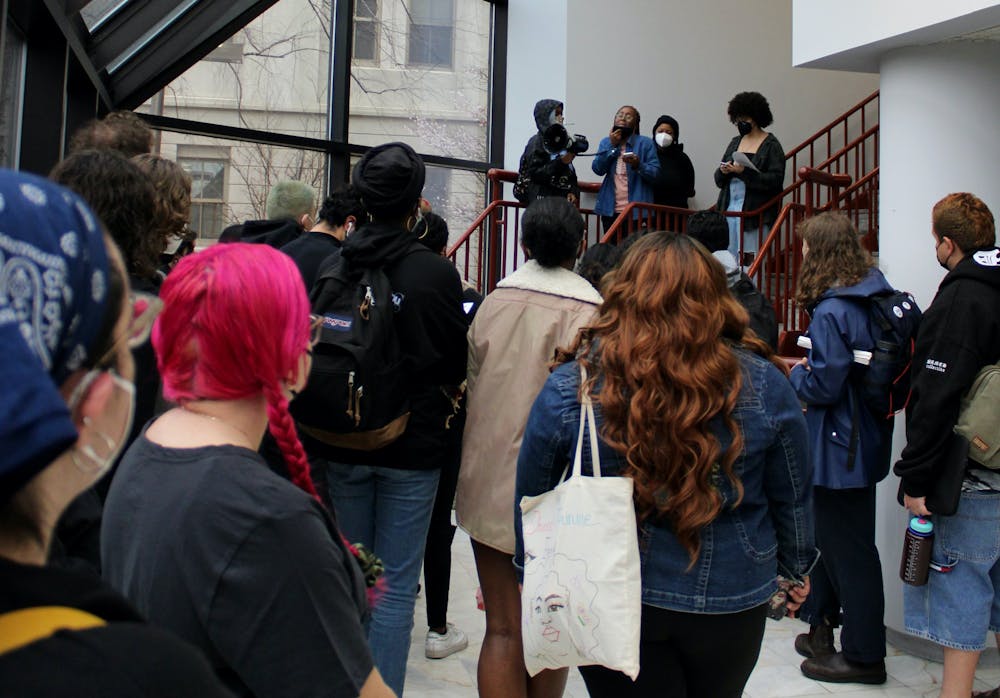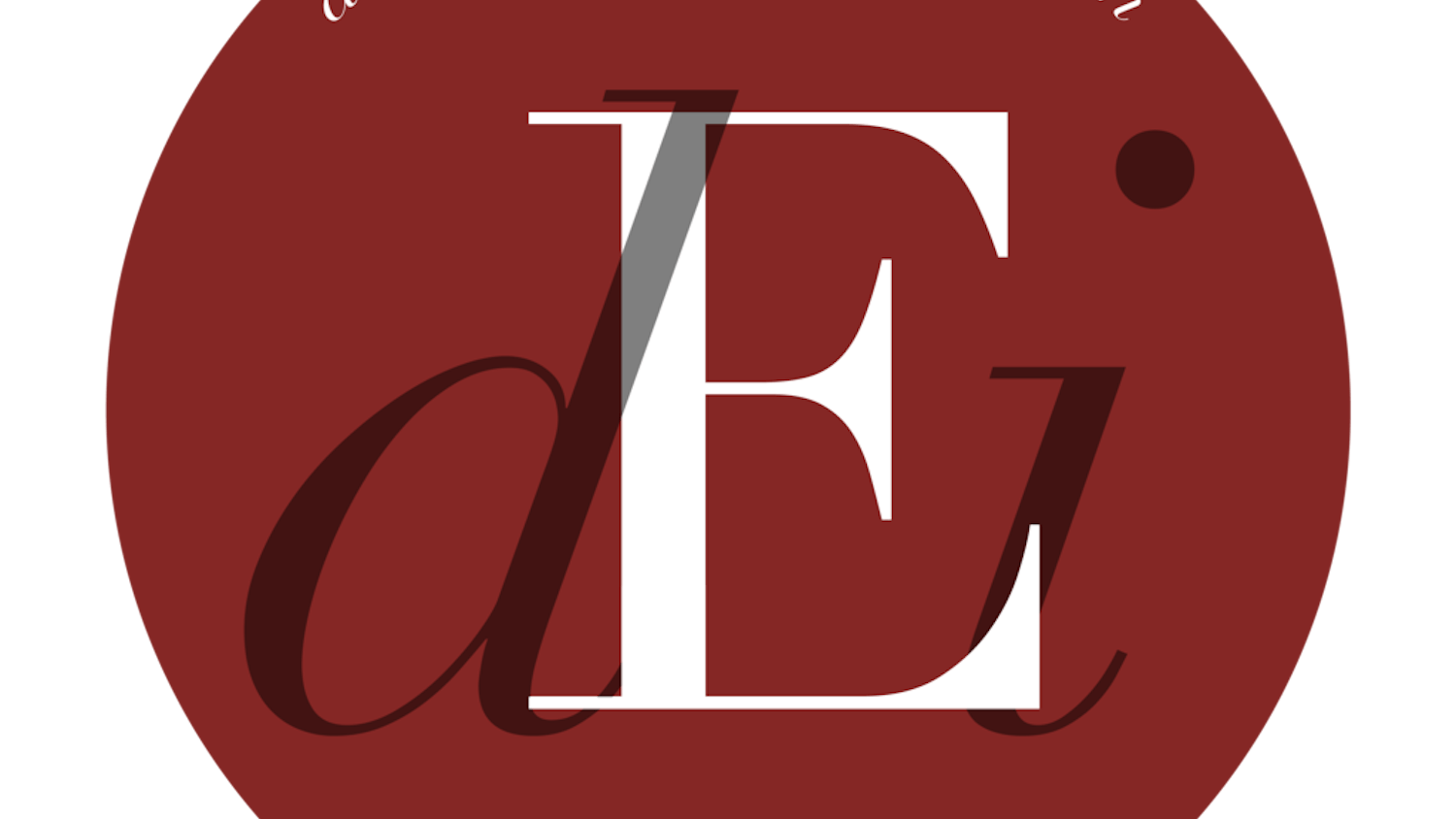Editor’s Note: Bridge Takeover Co-Organizer Kayla Kelly, The Eagle’s opinion managing editor, was not involved in the writing, reporting or editing of this story.
As students of color at American University struggle with racism, a conversation about steps forward was sparked with The Bridge Takeover last semester.
An Instagram account, @thebridgetakeover, was started a few months ago by Kayla Kelly, a rising senior in the School of Public Affairs, and since then multiple demonstrations have taken place in The Bridge Cafe.
Since the start of this movement, faculty, staff and students have started to enter into dialogue on the inclusivity of AU’s campus and what steps can be taken moving forward to support students of color.
The Bridge Takeover
Jadyn Newman, a rising senior in SPA and the School of Communication, is one of the four co-organizers of The Bridge Takeover. She said that the protests became a public call of action to the University and arose out of students of color wanting a safe space on campus.
“I think a lot of students at AU, specifically a lot of students of color, have honestly had a really hard time finding space on campus, both physically [and] emotionally, for our voices to be heard and to feel physically and psychologically safe,” Newman said. “And so we each noticed this issue in our own personal ways, and saw that it was a reflection of the greater experience of campus as a whole.”
After staging three sit-ins at The Bridge during the spring semester, all different styles of movements, with one being a silent sit-in and another being open mic style, Newman said it has been a “healing experience” for herself and many others as students of color start to look forward with a “united hope.”
A discussion with staff within University administration and The Bridge Cafe’s Manager David Gonzalez, a fifth-year senior in the College of Arts and Sciences, took place as a result of these protests.
Gonzalez said that he had talked with the organizers a couple of times and had a productive conversation with Kelly to go over some details of what is to come.
He said that what he believes to be much of the problem is the coronavirus pandemic placing a hold on community functions for two years and a “new class of people” at AU trying to get back into the groove of putting on events and programs.
“At the end of the day, we want to plan and do as many events as possible, but we just don't have the setup to do events scheduled that we're actually planning on a weekly or monthly basis,” Gonzalez said. “So a lot of that does need to come through student organizations that we then partner with.”
Michael Elmore, the director of the University Center, also explained that The Bridge is self-supporting financially, meaning that “anything that happens in that space money wise is because they were successful in selling,” so for that reason it cannot be an exclusive space.
Hub for Organizing, Multiculturalism and Equity
The Hub for Organizing, Multiculturalism and Equity (HOME) is a space that was opened in 2018 on the third floor of MGC, which was intended to be a safe space for students of color but has been largely neglected.
Elmore said that HOME was created after months of effort between former Student Government President Taylor Dumpson, the Office of Campus Life and the University Center. This idea was sparked from the student demonstrations in spring of 2017 when traffic was blocked in Bender Tunnel as students demanded action from the University after a racist hate crime targeting Dumpson.
“HOME was not essentially any one cultural group's space, but rather coming in here means it's a safe space for people who bought into these principles,” Elmore said.
These principles cultivated the idea that the people using HOME would be “accepting of everybody and engaging in meaning” said Elmore. Students can access the space by filling out a form that lays out the main principle of “mission and goal of continuing to foster a sense of community and belonging for our communities of color and allies.”
Elmore said that there was meant to be an assessment of the success of HOME, but a combination of students graduating, lack of promotional campaigns and the coronavirus pandemic shutting down operations over the past few years has caused that to not happen, pushing the space to the sidelines.
Currently, Elmore acknowledged that HOME might not be the space students of color need moving forward, but that it is his mission to find what that is for students.
“So this whole thing about I need a place, I need a community, I need a home — I need something that helps me find affinity for this place,” Elmore said. “We honestly at the University should be on a quest to make sure every student [can]. Everybody should be able to find something.”
When Newman was asked about HOME, she said that the intent of the space may have been well-meaning, but the impact is no longer significant. Because of this, Newman said more discussion should be fostered with students when constructing and running these spaces.
“A lot of times, though, the intention might be really good and strong with their mindset of inclusivity and diversity and making equitable experiences for all students,” Newman said. “I think the impact is not always as such, especially the impact on the big picture scale.”
The bigger picture
Looking at the larger problem of racism on campus, Newman said the University “has a long way to go in terms of showing in action that they value their students of color and trust their students of color.”
She said it is imperative that AU’s administration spends time hearing the actual needs and concerns of the students, letting them take the lead at times and continuing to foster an honest conversation.
“Not only relying on the visual appeal or how we sell ourselves, and more so on the real life daily lived experiences of students on this campus, which often is not reflective of the same diverse, inclusive, equitable culture that we preach, quote, unquote,” Newman said.
She said that for too long a burden has been placed on students to tell the administration about the discriminatory acts happening within the AU community and the culture can be improved.
“This university is plagued by reactiveness instead of proactiveness,” Newman said. “I think the problem is that for years BIPOC members of this community have been screaming at the top of their lungs to some degree about what goes on and what it's like to experience this institution, and it is met with reaction, but I don't feel like administration is often first to ask the questions.”
Donald Earl Collins, a professor of American Studies within the Department of Critical Race, Gender and Culture Studies, shared similar frustrations with the University’s response to racism.
Collins said that many members of AU’s community do not understand that the racism on campus and beyond is a systemic issue.
“Even if everyone suddenly had love in their heart for other people, specifically marginalized people, you have systems in place, which would still create gross inequalities just as a for instance,” Collins said.
Because of this, the everyday racist actions against BIPOC students, faculty and staff on AU’s campus go unnoticed or unresolved when addressed according to Collins.
The general response of the University to racism is an email from University officials to the community that Collins said leaves the community without any positive movement forward and a lack of anti-racism work being put into action.
“Yeah, we had a racist incident, we have put the fire out,” Collins said. “Let's send out the email that says we care, right, and then not do anything else.”
Echoing much of Newman’s point, Collins said that the University needs to take more time understanding what happens in the day to day on campus and meeting with members of the AU community to recognize their concerns and hear their suggestions for change.
“They're making a lot of decisions from on high without real input and real knowledge of what's going on on the ground,” Collins said. “If you want to address issues around race and racism, sexism, and sexual assault and all those other things, you got to be available.”
Current policies
Leslie Annexstein, the assistant vice president of the Equity and Title IX Office, explained the measures taken when events of discrimnation are reported by students on campus.
The first step under the discrimination policy is for the complaintant, or the person reporting the discrimination, to decide which means of resolution they wish to to take in regards to their case: formal or informal.
“Are they looking to sort of just get the situation resolved so that they feel more comfortable, or are they feeling like what occurred was so problematic to them and possibly others that they believe we need to investigate it?” Annexstein said. “Because if we find that there was a policy violation, the person should be disciplined in some way.”
Informal resolution follows the first model by solving the problem and making things better, whereas formal resolution brings in investigation about whether a violation has occurred and disciplinary action from that. For example, Annexstein said informal resolution could involve meditation of some sort with the person who reported and the person who was reported.
Annexstein shared her worries that many students do not understand that the Equity and Title IX Office works with discrimination issues just as much Title IX matters. She said that moving forward, the office has the important job of educating the AU community.
“We have a really big education job to do to get everyone to understand that there are two policies and that the University is committed to responding to: remedying and stamping out all forms of discrimination on campus,” Annexstein said.
Furthermore, she said that it is imperative that everyone understands their rights and the responsibilities that come with protecting and upholding those rights in the AU community.
“I hope that we can lay a really solid foundation at the University where everyone understands that if they do believe that they faced any form of discrimination, there's a place they can go that will respond with care and openness and sensitivity,” Annexstein said.
Solidarity today
For now, Newman said, while changes still need to be made, she has found support within the AU community and beyond.
“For me personally I have felt the most supported by, first and foremost, definitely my peers,” Newman said. “I think there is no better support than someone who's experienced something similar.”
Additionally, she stressed the importance of students of color seeking out professors that share their identities. She said that they can be “fantastic mentors,” unintentionally or not, sharing wisdom and helping students get the resources they need.
The place she found unexpected community was in forming connections with people of color on the staff on campus with the bus drivers or employees in TDR.
“I think a lot of students look past those relationships as something that's meaningful, but they really, really are because being able to find that community in other members of this campus there's no way to put a value to that,” Newman said. “It's truly invaluable.”





